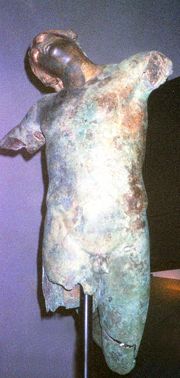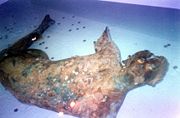
Dancing Satyr of Mazara del Vallo
Encyclopedia

Mazara del Vallo
Mazara del Vallo is a town and comune in southwestern Sicily, Italy, which lies mainly on the left bank at the mouth of the Mazaro river, administratively part of the province of Trapani....
is a Greek bronze
Bronze
Bronze is a metal alloy consisting primarily of copper, usually with tin as the main additive. It is hard and brittle, and it was particularly significant in antiquity, so much so that the Bronze Age was named after the metal...
statue
Statue
A statue is a sculpture in the round representing a person or persons, an animal, an idea or an event, normally full-length, as opposed to a bust, and at least close to life-size, or larger...
, whose refinement and rapprochement with the manner of Praxiteles
Praxiteles
Praxiteles of Athens, the son of Cephisodotus the Elder, was the most renowned of the Attic sculptors of the 4th century BC. He was the first to sculpt the nude female form in a life-size statue...
has made it a subject of discussion.
Style and details
Though the satyr is missing both arms, one leg and its separately-cast tail (originally fixed in a surviving hole at the base of the spine), its head and torso are remarkably well-preserved despite millennia spent at the bottom of the sea. The satyr is depicted in mid-leap, head thrown back ecstatically and back arched, his hair swinging with the movement of his head. The facture is highly refined; the whites of his eyes are inlays of white alabaster.Though some have dated it to the 4th century BCE and said it was an original work by Praxiteles or a faithful copy, it is more securely dated either to the Hellenistic period of the 3rd and 2nd centuries BCE, or possibly to the "Atticising" phase of Roman taste
Neo-Attic
Neo-Attic or Atticizing is a sculptural style, beginning in Hellenistic sculpture and vase-painting of the 2nd century BCE and climaxing in Roman art of the 2nd century CE, copying, adapting or closely following the style shown in reliefs and statues of the Classical and Archaic periods...
in the early 2nd century CE. A high percentage of lead in the bronze alloy suggests its being made in Rome itself.

Rediscovery and display
The torso was recovered from the sandy sea floor at a depth of 500 m (1600 ft.) off the southwestern coast of SicilySicily
Sicily is a region of Italy, and is the largest island in the Mediterranean Sea. Along with the surrounding minor islands, it constitutes an autonomous region of Italy, the Regione Autonoma Siciliana Sicily has a rich and unique culture, especially with regard to the arts, music, literature,...
, on the night of March 4, 1998, in the nets of the same fishing boat (operating from Mazara del Vallo
Mazara del Vallo
Mazara del Vallo is a town and comune in southwestern Sicily, Italy, which lies mainly on the left bank at the mouth of the Mazaro river, administratively part of the province of Trapani....
, hence the sculpture's name) that had in the previous year recovered the sculpture's left leg. Other well-known underwater finds of Greek bronzes have been retrieved from the Aegean
Aegean Sea
The Aegean Sea[p] is an elongated embayment of the Mediterranean Sea located between the southern Balkan and Anatolian peninsulas, i.e., between the mainlands of Greece and Turkey. In the north, it is connected to the Marmara Sea and Black Sea by the Dardanelles and Bosporus...
and Mediterranean
Mediterranean Sea
The Mediterranean Sea is a sea connected to the Atlantic Ocean surrounded by the Mediterranean region and almost completely enclosed by land: on the north by Anatolia and Europe, on the south by North Africa, and on the east by the Levant...
seas, generally from shipwreck
Shipwreck
A shipwreck is what remains of a ship that has wrecked, either sunk or beached. Whatever the cause, a sunken ship or a wrecked ship is a physical example of the event: this explains why the two concepts are often overlapping in English....
sites: the Antikythera mechanism
Antikythera mechanism
The Antikythera mechanism is an ancient mechanical computer designed to calculate astronomical positions. It was recovered in 1900–1901 from the Antikythera wreck. Its significance and complexity were not understood until decades later. Its time of construction is now estimated between 150 and 100...
, the Antikythera Ephebe and the portrait head of a Stoic
STOIC
STOIC was a variant of Forth.It started out at the MIT and Harvard Biomedical Engineering Centre in Boston, and was written in the mid 1970s by Jonathan Sachs...
discovered by sponge-divers at Antikythera in 1900, the Mahdia shipwreck
Mahdia shipwreck
The shipwreck of Mahdia was found by sponge fishermen off the coast of Tunisia in June 1907. The shipwreck near the modern town of Mahdia is dated about the 80s BC, or even later....
off the coast of Tunisia, 1907; the Marathon Boy
Marathon Boy
-Movie:Marathon Boy is the title of a feature-length documentary movie on Budhia Singh, directed by Gemma Atwal. -Statue:The Marathon Boy or Ephebe of Marathon is a Greek bronze sculpture found in the Aegean Sea in the bay of Marathon in 1925; it is conserved in the National Archaeological Museum...
off the coast of Marathon, 1925; the standing Poseidon of Cape Artemision found off Cape Artemision in northern Euboea, 1926; the horse and Rider found off Cape Artemision, 1928 and 1937; the Getty Victorious Youth found off Fano
Fano
Fano is a town and comune of the province of Pesaro and Urbino in the Marche region of Italy. It is a beach resort 12 km southeast of Pesaro, located where the Via Flaminia reaches the Adriatic Sea...
on the Adriatic coast
Adriatic Sea
The Adriatic Sea is a body of water separating the Italian Peninsula from the Balkan peninsula, and the system of the Apennine Mountains from that of the Dinaric Alps and adjacent ranges...
of Italy; the Riace bronzes, found in 1972; and the Apoxyomenos
Apoxyomenos
Apoxyomenos is one of the conventional subjects of ancient Greek votive sculpture; it represents an athlete, caught in the familiar act of scraping sweat and dust from his body with the small curved instrument that the Romans called a strigil....
recovered from the sea off the Croatia
Croatia
Croatia , officially the Republic of Croatia , is a unitary democratic parliamentary republic in Europe at the crossroads of the Mitteleuropa, the Balkans, and the Mediterranean. Its capital and largest city is Zagreb. The country is divided into 20 counties and the city of Zagreb. Croatia covers ...
n island of Lošinj
Lošinj
Lošinj is a Croatian island in the northern Adriatic Sea, in the Kvarner Gulf. It is almost due south of the city of Rijeka and part of the Primorje-Gorski Kotar county....
in 1999.
Restoration at the Istituto Centrale per il Restauro, Rome, included a steel armature so that the statue can be displayed upright. When first displayed to the public after conservation (in the Chamber of Deputies
Chamber of Deputies
Chamber of deputies is the name given to a legislative body such as the lower house of a bicameral legislature, or can refer to a unicameral legislature.-Description:...
in Rome, from 31 March to 2 June 2003), it was hailed as the finest new discovery in Italian waters since the Riace bronzes were found in 1972. On July 12, 2003 it returned to Mazara del Vallo, where it is on permanent display in the Museo del Satiro in the church of Sant'Egidio. There, it is provided with an anti-seismic
Seismic retrofit
Seismic retrofitting is the modification of existing structures to make them more resistant to seismic activity, ground motion, or soil failure due to earthquakes. With better understanding of seismic demand on structures and with our recent experiences with large earthquakes near urban centers,...
base, to secure it against tremors in this earthquake zone. From March 23 to June 28, 2007 it toured to the Louvre
Louvre
The Musée du Louvre – in English, the Louvre Museum or simply the Louvre – is one of the world's largest museums, the most visited art museum in the world and a historic monument. A central landmark of Paris, it is located on the Right Bank of the Seine in the 1st arrondissement...
for their Praxiteles exhibition, and an associated Louvre interactive installation, "Connaître la forme" ("Know your form"), displayed a replica of it lit in various ways to demonstrate the importance of lighting in displaying a sculpture.

